Oxbow Classics in Egyptology
Publisher: Oxbow Books
This series comprises facsimile re-issues of typological catalogues produced by W.M. Flinders Petrie based on his vast collection of Egyptian artefacts. Mostly excavated by Petrie during many seasons of campaign in the last years of the 19th and early decades of the 20th century, they now reside in the Petrie Museum of Egyptian and Sudanese Archaeology at University College, London. Published between 1898 and 1937, and long out of print, the catalogues were re-issued in facsimile by publishers Aris and Philips in the 1970s alongside titles newly commissioned, based on more recent examination of elements of the Petrie Collection by contemporary experts.
The Oxbow Classics in Egyptology series makes a selection of these important resources available again in print for a new generation of students and scholars, for whom the archaeology of Egypt continues to fascinate. Multi-disciplinary investigation and research continues unabated, encompassing methodologies, scientific and data processing techniques, theoretical approaches, and even whole paradigms that were unheard of in the 1970s and undreamt of when Petrie was working in Egypt. Yet all the titles included in this series continue to be invaluable sources of basic data, providing an unparalleled resource that can easily be cross-referenced with the actual materials they describe and discuss. They remain within the Petrie Collection where they may be accessed and re-examined as new research flourishes. As historic documents, the Petrie catalogues stand as exemplars of the craft of typological classification, the backbone of modern archaeology – much of which, though refined by absolute dating and another 100 years of research, still stands the test of time.
(Print binding: Paperback | Format: 297 x 210 mm, except where stated otherwise)This series comprises facsimile re-issues of typological catalogues produced by W.M. Flinders Petrie based on his vast collection of Egyptian artefacts. Mostly excavated by Petrie during many seasons of campaign in the last years of the 19th and early decades of the 20th century, they now reside in the Petrie Museum of Egyptian and Sudanese Archaeology at University College, London. Published between 1898 and 1937, and long out of print, the catalogues were re-issued in facsimile by publishers Aris and Philips in the 1970s alongside titles newly commissioned, based on more recent examination of elements of the Petrie Collection by contemporary experts.
The Oxbow Classics in Egyptology series makes a selection of these important resources available again in print for a new generation of students and scholars, for whom the archaeology of Egypt continues to fascinate. Multi-disciplinary investigation and research continues unabated, encompassing methodologies, scientific and data processing techniques, theoretical approaches, and even whole paradigms that were unheard of in the 1970s and undreamt of when Petrie was working in Egypt. Yet all the titles included in this series continue to be invaluable sources of basic data, providing an unparalleled resource that can easily be cross-referenced with the actual materials they describe and discuss. They remain within the Petrie Collection where they may be accessed and re-examined as new research flourishes. As historic documents, the Petrie catalogues stand as exemplars of the craft of typological classification, the backbone of modern archaeology – much of which, though refined by absolute dating and another 100 years of research, still stands the test of time.
(Print binding: Paperback | Format: 297 x 210 mm, except where stated otherwise)This series comprises facsimile re-issues of typological catalogues produced by W.M. Flinders Petrie based on his vast collection of Egyptian artefacts. Mostly excavated by Petrie during many seasons of campaign in the last years of the 19th and early decades of the 20th century, they now reside in the Petrie Museum of Egyptian and Sudanese Archaeology at University College, London. Published between 1898 and 1937, and long out of print, the catalogues were re-issued in facsimile by publishers Aris and Philips in the 1970s alongside titles newly commissioned, based on more recent examination of elements of the Petrie Collection by contemporary experts.
The Oxbow Classics in Egyptology series makes a selection of these important resources available again in print for a new generation of students and scholars, for whom the archaeology of Egypt continues to fascinate. Multi-disciplinary investigation and research continues unabated, encompassing methodologies, scientific and data processing techniques, theoretical approaches, and even whole paradigms that were unheard of in the 1970s and undreamt of when Petrie was working in Egypt. Yet all the titles included in this series continue to be invaluable sources of basic data, providing an unparalleled resource that can easily be cross-referenced with the actual materials they describe and discuss. They remain within the Petrie Collection where they may be accessed and re-examined as new research flourishes. As historic documents, the Petrie catalogues stand as exemplars of the craft of typological classification, the backbone of modern archaeology – much of which, though refined by absolute dating and another 100 years of research, still stands the test of time.
(Print binding: Paperback | Format: 297 x 210 mm, except where stated otherwise)This series comprises facsimile re-issues of typological catalogues produced by W.M. Flinders Petrie based on his vast collection of Egyptian artefacts. Mostly excavated by Petrie during many seasons of campaign in the last years of the 19th and early decades of the 20th century, they now reside in the Petrie Museum of Egyptian and Sudanese Archaeology at University College, London. Published between 1898 and 1937, and long out of print, the catalogues were re-issued in facsimile by publishers Aris and Philips in the 1970s alongside titles newly commissioned, based on more recent examination of elements of the Petrie Collection by contemporary experts.
The Oxbow Classics in Egyptology series makes a selection of these important resources available again in print for a new generation of students and scholars, for whom the archaeology of Egypt continues to fascinate. Multi-disciplinary investigation and research continues unabated, encompassing methodologies, scientific and data processing techniques, theoretical approaches, and even whole paradigms that were unheard of in the 1970s and undreamt of when Petrie was working in Egypt. Yet all the titles included in this series continue to be invaluable sources of basic data, providing an unparalleled resource that can easily be cross-referenced with the actual materials they describe and discuss. They remain within the Petrie Collection where they may be accessed and re-examined as new research flourishes. As historic documents, the Petrie catalogues stand as exemplars of the craft of typological classification, the backbone of modern archaeology – much of which, though refined by absolute dating and another 100 years of research, still stands the test of time.
(Print binding: Paperback | Format: 297 x 210 mm, except where stated otherwise)
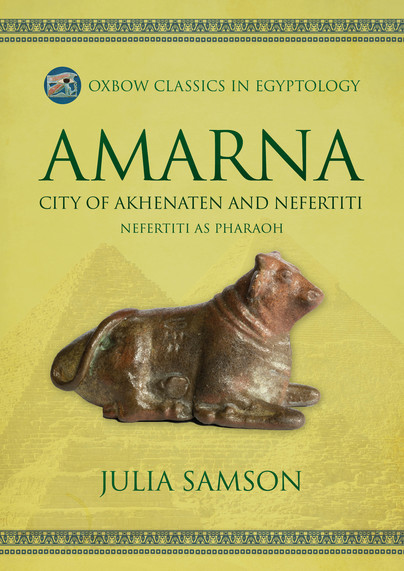
Format: Paperback
Pages: 154
ISBN: 9798888570265
Pub Date: 15 Jul 2023
Description:
Tell el-Amarna is the modern name for the ancient Egyptian city of Akhenaten, situated in a bay of hills formed by the cliffs of the eastern desert about halfway between Cairo and Luxor. The city was founded in the 14th century BC by the Pharaoh Akhenaten to be a royal palace for himself and his wife Nefertiti, the capital of all Egypt, and the center of the state cult of the Sun God in the form of Aten (sun disc), which became an obsession of the Pharaoh. The city contained temples, palaces, state buildings and great private mansions, but was abandoned by Akhenaten’s successor, his son Tutenkhamen.
The city was demolished, never to be re-inhabited. This volume presents a detailed, illustrated catalogue of the many statues, statuettes, reliefs, inlays and inscriptions recorded and collected by Flinders Petrie, together with glass and faience objects and moulds. Part II provides a summary of developments in royal names and titles with a discussion on research into names and evidence of royal status. This series comprises facsimile re-issues of typological catalogues produced between 1898 and 1937 by W.M. Flinders Petrie, based on his vast collection of Egyptian artefacts which now reside in The Petrie Museum of Egyptian and Sudanese Archaeology, University College, London. Long out of print, the catalogues were re-issued in facsimile by publishers Aris & Phillips in the 1970s alongside newly-commissioned titles by contemporary experts. Petrie’s catalogues remain invaluable source material today. The Oxbow Classics in Egyptology series now makes a selection of these important resources available again in print for a new generation of students and scholars.
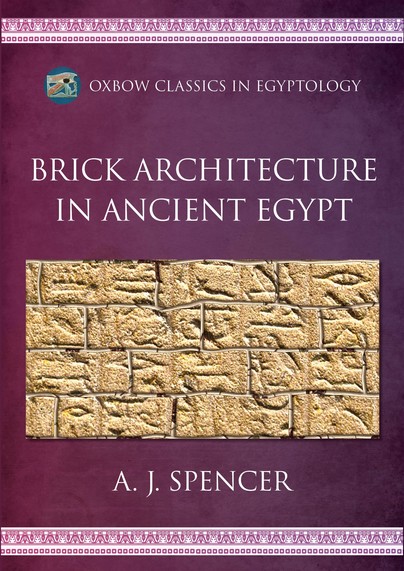
Format: Paperback
Pages: 192
ISBN: 9798888570302
Pub Date: 15 Jul 2023
Description:
First published in 1979, this facsimile edition of Jeffrey Spencer’s comprehensive study provides a detailed account of the brick architecture of ancient Egypt. Part I provides introductory information on brick manufacture, early use of brick in Egypt and explains the corpus of brick bonding systems. Part II provides an account of the surviving brick buildings, discussed by type, with special reference to technical and structural matter.
Part III presents an examination of the constructional techniques employed at different periods for various purposes. A discussion of the kinds of bricks used, their sizes, and bonding is included. This series comprises facsimile re-issues of typological catalogues produced between 1898 and 1937 by W.M. Flinders Petrie, based on his vast collection of Egyptian artefacts which now reside in The Petrie Museum of Egyptian and Sudanese Archaeology, University College, London. Long out of print, the catalogues were re-issued in facsimile by publishers Aris & Phillips in the 1970s alongside newly-commissioned titles by contemporary experts – of which Brick Architecture in Ancient Egypt is one. The Oxbow Classics in Egyptology series makes a selection of these important resources – which remain invaluable source material – available again in print for a new generation of students and scholars.
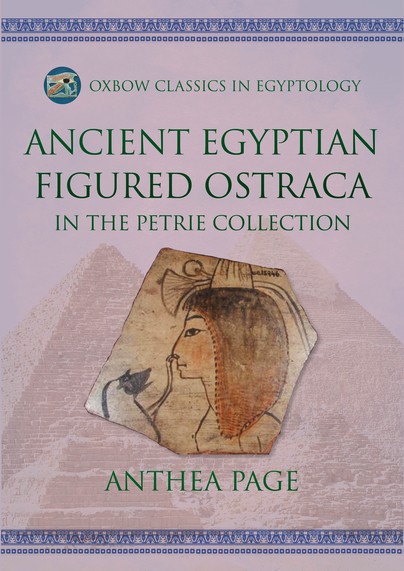
Format: Paperback
Pages: 128
ISBN: 9798888570241
Pub Date: 15 Jun 2023
Description:
This facsimile reissue of Anthea Page’s 1983 catalogue makes this important source material available again in print for a new generation of students and scholars. The catalogue documents 82 ostraca held in The Petrie Museum of Egyptian and Sudanese Archaeology collection in London.Ostraca are flakes of limestone or broken sherds of pottery used essentially as 'notepads' for private letters; laundry lists; records of purchases; roughly inscribed images of people, birds, and animals; and copies of literary works.
In Ancient Egypt they reveal the artist-craftsman at practice, leisure and play. Apprentices, for instance, copied scenes to improve techniques; artists drew pictures to amuse, perhaps with satirical images and caricatures, or made measured studies for finished works. A wide range of trivial examples survive, together with more serious devotional, votive and dedicatory pieces.
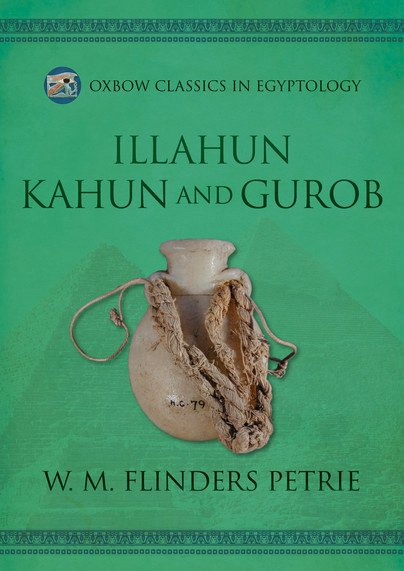
Format: Paperback
Pages: 98
ISBN: 9798888570227
Pub Date: 15 Jun 2023
Description:
Flinders Petrie undertook excavation and survey of ancient Egyptian towns in the Faiyum oasis, south-west of Cairo, in 1888–90. The work included opening of a pyramid at Illahun and excavation of a nearby cemetery, excavation and planning of over 2000 chambers of the city of Kahun, excavation of a Ptolemaic cemetery at Gurob, and work at the temple site at Medinet Gurob. This facsimile volume presents brief descriptions of the work with a focus on the artifacts and inscriptions recovered and recorded with an attempt to establish a chronology of occupation in the oasis.
The entrance to the pyramid at Illahun, its peculiar structure and exploration of its various internal passages and chambers are described, including the sepulchre containing the red granite sarcophagus of Usertesen II, accompanied by a table of offerings. A series of nearby tombs produced a wealth of artifacts associated with burials, wooden coffins and cartonnages, including glazed objects, amulets, scarabs, beads, silver cowries, carved and inscribed wooden objects and statuettes. At Kahun the complete surviving plan of the ancient town revealed a regular layout thought by Petrie to be the work of a single architect. He identified the acropolis, at least eight great houses, dwelling houses, rubbish heaps, and storerooms arranged along numerous narrow ‘workmen’s’ streets with drainage channels. Much evidence for construction materials and techniques and house fittings, wall plaster and paint was recovered. Portable objects included decorated pottery, some of it imported; pottery trays of offerings; stonework; wooden carvings; flint sickles and knives; inscribed stelae; a variety of copper tools; scarabs and clay seals; stone weights and many tools, including several workshop groups. A family tomb in the cellar beneath one house contained 12 coffins, each containing several bodies with grave offerings buried in succession, two baby boxes and a heap of offerings. At Gurob, the plan of the main temple and surrounding enclosures, within which were contained most of the houses, was established and an outline of its history determined. An unusual practice of burning personal belongings in pits beneath the houses was identified and the groups of objects and inscriptions discussed. The nearby cemetery was also investigated with pit-like tombs producing undecorated coffins but finely painted cartonnages, badly decomposed papyri and a few funerary objects. A discussion of the wider urban landscape concludes the narrative. There are specialist reports on the papyri and stone implements. This series comprises facsimile re-issues of typological catalogues produced between 1898 and 1937 by W.M. Flinders Petrie, and re-issued in facsimile by publishers Aris & Phillips in the 1970s alongside newly-commissioned titles by contemporary experts. Petrie’s catalogues remain invaluable source material today. The Oxbow Classics in Egyptology series now makes a selection of these important resources available again in print for a new generation of students and scholars.
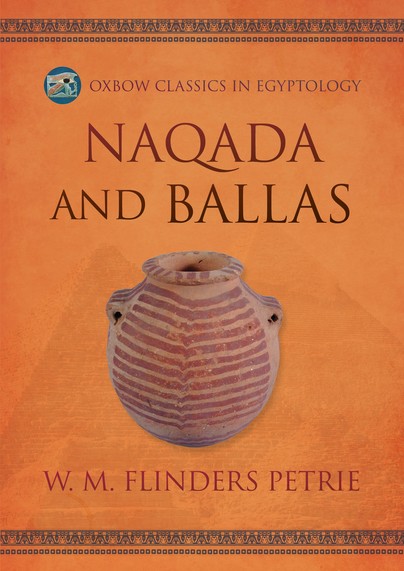
Format: Paperback
Pages: 188
ISBN: 9798888570203
Pub Date: 15 Jun 2023
Description:
Facsimile edition of the 1974 reissue of Flinders Petrie’s 1896 account of the excavation (mainly) of tombs in the area around Ballas and Naqada on the edge of the Egyptian desert, 30 miles north of Thebes. Several areas of the ancient towns of Deir and Nubt – the latter identified as the center of Set worship – and more tombs were investigated. At each cemetery, traditionally furnished Old and Middle Kingdom tombs were examined and many proved to have been plundered and reused in antiquity.
Petrie named these later burials as of a New Race and describes them in detail at Ballas and Naqada. A collection of mostly Palaeolithic flint artefacts is also described. This series comprises facsimile re-issues of typological catalogues produced between 1898 and 1937 by W.M. Flinders Petrie, based on his vast collection of Egyptian artefacts which now reside in The Petrie Museum of Egyptian and Sudanese Archaeology, University College, London. Long out of print, the catalogues were re-issued in facsimile by publishers Aris & Phillips in the 1970s alongside newly-commissioned titles by contemporary experts. Petrie’s catalogues remain invaluable source material today. The Oxbow Classics in Egyptology series now makes a selection of these important resources available again in print for a new generation of students and scholars.
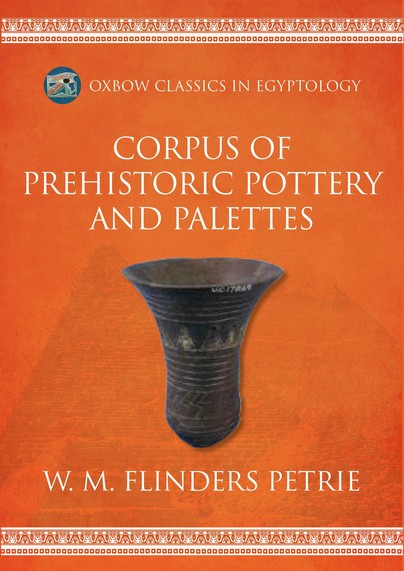
Format: Paperback
Pages: 68
ISBN: 9798888570180
Pub Date: 15 Mar 2023
Description:
Facsimile edition of the 1974 reissue of Flinders Petrie’s 1921 corpus of prehistoric pottery and slate palettes from pre-dynastic, prehistoric Egypt. The pottery corpus was produced separately to accompany the catalogue of Egyptian artifacts in the volume Prehistoric Egypt and comprises hundreds of line drawings illustrating the shapes, forms and types of decoration. It was intended to be a ‘graveside’ aid for use during excavation, with the intent that it be used with record cards to classify and date pottery that could then be returned to the grave.
The corpus of palettes updated Petrie’s original classification published Ballas and Naqada, to include many new finds and refine the typology and sequence. This series comprises facsimile re-issues of typological catalogues produced between 1898 and 1937 by W.M. Flinders Petrie, based on his vast collection of Egyptian artefacts which now reside in The Petrie Museum of Egyptian and Sudanese Archaeology, University College, London. Long out of print, the catalogues were re-issued in facsimile by publishers Aris & Phillips in the 1970s alongside newly-commissioned titles by contemporary experts. Petrie’s catalogues remain invaluable source material today. The Oxbow Classics in Egyptology series now makes a selection of these important resources available again in print for a new generation of students and scholars.
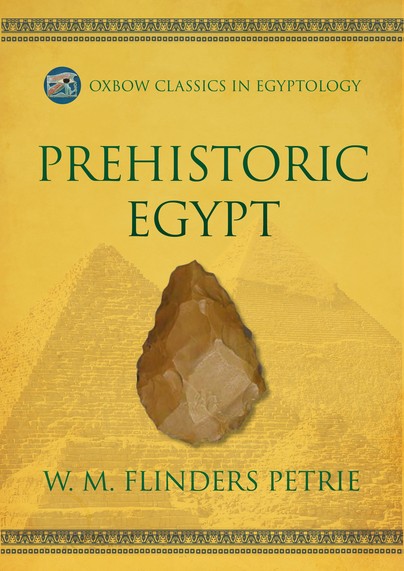
Format: Paperback
Pages: 114
ISBN: 9798888570166
Pub Date: 15 Mar 2023
Description:
This is the facsimile edition of the 1974 reissue of Flinders Petrie’s 1921 description and catalogue of pre-dynastic, prehistoric artifacts from Egypt. Draws together evidence from various excavations and surveys undertaken by himself and others to present a fully illustrated, detailed catalogue of recovered artifacts of flint, other stone, clay, pottery, ivory/tusk and bone, metalwork, wood, shell and glass. He attempts to establish relative dating sequence based on a combination of object typologies and grave associations, combined with the then-latest geological and sedimentological information, concluding that the material covered a period from around 10,000–5000 BC.
Objects are described by material and form, set within his established chronological framework.This series comprises facsimile re-issues of typological catalogues produced between 1898 and 1937 by W.M. Flinders Petrie, based on his vast collection of Egyptian artefacts which now reside in The Petrie Museum of Egyptian and Sudanese Archaeology, University College, London. Long out of print, the catalogues were re-issued in facsimile by publishers Aris & Phillips in the 1970s alongside newly-commissioned titles by contemporary experts. Petrie’s catalogues remain invaluable source material today. The Oxbow Classics in Egyptology series now makes a selection of these important resources available again in print for a new generation of students and scholars.
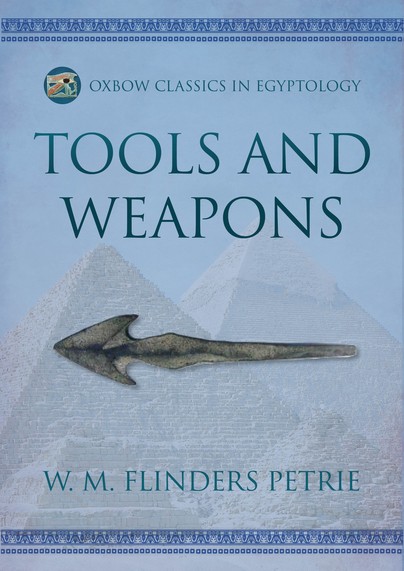
Format: Paperback
Pages: 158
ISBN: 9798888570142
Pub Date: 15 Mar 2023
Description:
Facsimile edition of the 1974 reissue of Flinders Petrie’s 1917 pioneering typological catalogue of Egyptian metal, wooden and composite tools and weapons, one of a number of such catalogues to be reissued in this new series. The volume is arranged by category, first of general tools, including axes, chisels and knives, and then weapons, such as daggers and spears. This is followed by sections on woodworking (artisans') and builders’ tools, personal items, agricultural equipment and a range of domestic items.
Within each category, sub-categories are defined, described and discussed and the full range is illustrated as outline drawings and photographs across 79 plates. The catalogue addresses questions of chronology, typological development, and distribution, and provides a limited discussion of comparable material from outside Egypt. This series comprises facsimile re-issues of typological catalogues produced between 1898 and 1937 by W.M. Flinders Petrie, based on his vast collection of Egyptian artefacts which now reside in The Petrie Museum of Egyptian and Sudanese Archaeology, University College, London. Long out of print, the catalogues were re-issued in facsimile by publishers Aris & Phillips in the 1970s alongside newly-commissioned titles by contemporary experts. Petrie’s catalogues remain invaluable source material today. The Oxbow Classics in Egyptology series now makes a selection of these important resources available again in print for a new generation of students and scholars.
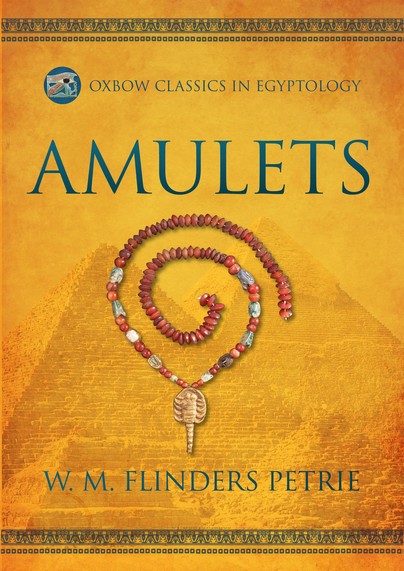
Format: Paperback
Pages: 144
ISBN: 9798888570005
Pub Date: 15 Feb 2023
Illustrations: Fully illustrated with photographs and illustrations
Description:
This facsimile edition of the 1972 reissue of Flinders Petrie’s 1914 pioneering typological catalogue of Egyptian amulets, is one of a number of such catalogues to be reissued in this new series. Remarkably – although points of detail emanating from more recent research have surfaced – it remains unsurpassed in its comprehensive description, typological classification, and interpretation. While an absence of reasoned argument for the dating of his various groups is a weak point of Petrie’s study from the point of view of modern scholarship, his attention to detail and careful consideration of typology and potential meaning, borne of decades of observation, means that this, and the other catalogues in the series, remain as invaluable reference books for Egyptologists.
Based on examination of his own extensive collection of Egyptian artifacts, Petrie presents a typologically ordered catalogue divided into seven main groups defined on the basis of interpretation rather than subject: amulets of ‘similar’ kind, for example, relating to body parts; power; property; protection; human-headed; animal-headed; and animal gods. Each class of object is described along with its varieties: material, distribution, position within burials, its chronological position as defined by Petrie himself, and its meaning interpreted. Collections containing examples are listed and hundreds of objects are presented in photographs and a selection of burial associations illustrated by coffin plans.
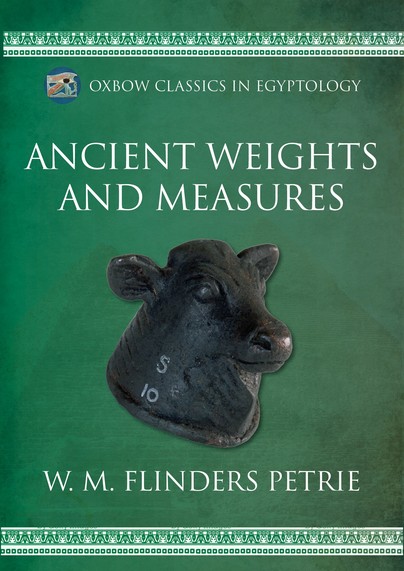
Format: Paperback
Pages: 110
ISBN: 9798888570104
Pub Date: 15 Feb 2023
Illustrations: Fully illustrated
Description:
This facsimile volume of detailed catalogues prepared by Sir Flinders Petrie of ancient weights and measures, is based on examination of over 4,000 Egyptian weights within his collections. Eight standards have been identified and are described. The text discusses forms, multiples and fractions of standard weights, materials, and evidence for the adoption of different standards.
A much smaller collection of steelyards, measures of capacity, lineal measures, and balances is also described and illustrated. This volume is part of a new series comprising facsimile re-issues of typological catalogues produced between 1898 and 1937 by W. M. Flinders Petrie, based on his vast collection of Egyptian artefacts. Mostly excavated by Petrie during many seasons of campaign in the latter years of the 19th and early decades of the 20th century, these artefacts now reside in the Petrie Museum at University College, London. Long out of print, the catalogues were re-issued in facsimile by publishers Aris & Phillips in the 1970s alongside newly-commissioned titles, based on more recent examination of elements of the Petrie Collection by contemporary experts. The Oxbow Classics in Egyptology series makes a selection of these important resources available again in print for a new generation of students and scholars.
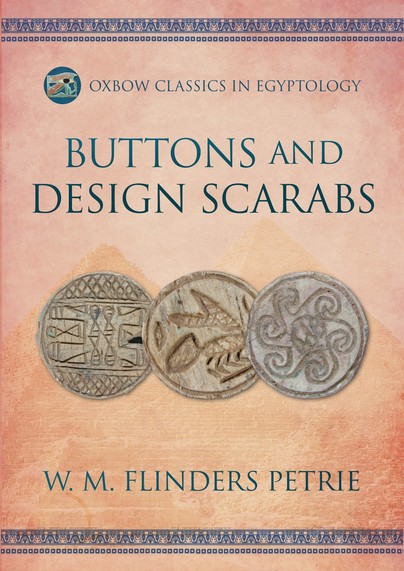
Format: Paperback
Pages: 68
ISBN: 9798888570043
Pub Date: 15 Feb 2023
Illustrations: Fully illustrated with photographs and illustrations
Description:
This facsimile reissue of Flinders Petrie’s extensive catalog of buttons and scarabs describes and illustrates over 1500 examples, along with an appendix on additions to the ‘Scarabs and Cylinders’ volume published earlier. In keeping with his other object catalogs, Petrie devises object classifications based on form with an attempt at dating their sequences. He describes the back of the objects, materials, their designs and inscriptions, and offers ideas on their meanings.
Particular attention is paid to animal and human representations and those possibly of gods. He also identifies several local series.This volume is part of a new series comprising facsimile re-issues of typological catalogues produced between 1898 and 1937 by Sir W. M. Flinders Petrie, based on his vast collection of Egyptian artefacts. Mostly excavated by Petrie during many seasons of campaign in the latter years of the 19th and early decades of the 20th century, these artefacts now reside in the Petrie Museum at University College, London. Long out of print, the catalogues were re-issued in facsimile by publishers Aris & Phillips in the 1970s alongside newly-commissioned titles, based on more recent examination of elements of the Petrie Collection by contemporary experts. The Oxbow Classics in Egyptology series makes a selection of these important resources available again in print for a new generation of students and scholars.
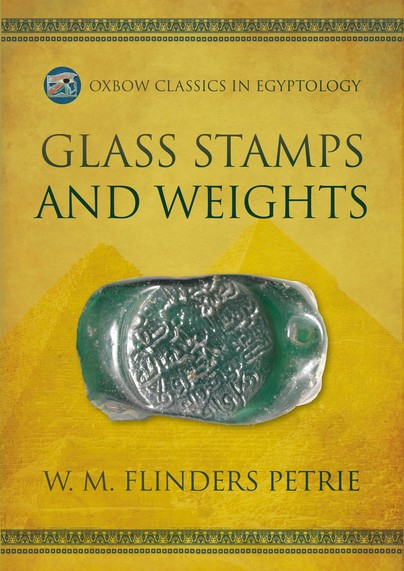
Format: Paperback
Pages: 58
ISBN: 9798888570081
Pub Date: 15 Feb 2023
Illustrations: Fully illustrated with photographs and line drawings
Description:
A facsimile volume of a detailed catalogue prepared by Flinders Petrie on artifacts largely collected from his Egyptian explorations of a series of glass stamps of Egyptian manufacture that were used from the Roman to Abbasid period variously as tokens, counters, weights, or attached to glass cups as indications of measure. Various categories are identified and described, makers’ names discussed, and weight standards considered. Over 700 stamps are illustrated both as photographs and transcribed line drawings.
This volume is part of a new series comprising facsimile re-issues of typological catalogues produced between 1898 and 1937 by W. M. Flinders Petrie, based on his vast collection of Egyptian artefacts. Mostly excavated by Petrie during many seasons of campaign in the latter years of the 19th and early decades of the 20th century, these artefacts now reside in the Petrie Museum at University College, London. Long out of print, the catalogues were re-issued in facsimile by publishers Aris & Phillips in the 1970s alongside newly-commissioned titles, based on more recent examination of elements of the Petrie Collection by contemporary experts. The Oxbow Classics in Egyptology series makes a selection of these important resources available again in print for a new generation of students and scholars.
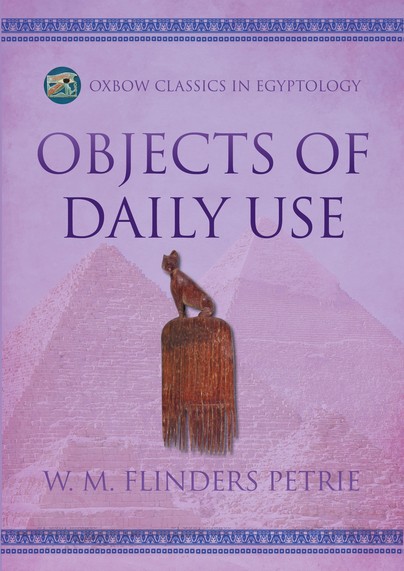
Format: Paperback
Pages: 110
ISBN: 9798888570128
Pub Date: 15 Feb 2023
Illustrations: Fully illustrated
Description:
A facsimile edition of the 1974 reissue of Flinders Petrie’s fully illustrated 1927 description and catalogue of personal and everyday Egyptian and Roman objects in his collections. Jewellery items include necklaces, bracelets, rings, and earrings, many made from precious metals and/or incorporating gemstones or beads. Toilet items include mirrors, combs, kohl pots, and sticks.
Magic wands, manufactured to provide protection and carved from bone and ivory are described, along with examples carved as hands and found in pairs. Board games are represented by playing pieces and gameboards relating to a number of known games. Toys, writing equipment, fragments of furniture, walking sticks and basketry are all catalogued. This volume is part of a new series comprising facsimile re-issues of typological catalogues produced between 1898 and 1937 by W. M. Flinders Petrie, based on his vast collection of Egyptian artefacts. Mostly excavated by Petrie during many seasons of campaign in the latter years of the 19th and early decades of the 20th century, these artefacts now reside in the Petrie Museum at University College, London. Long out of print, the catalogues were re-issued in facsimile by publishers Aris & Phillips in the 1970s alongside newly-commissioned titles, based on more recent examination of elements of the Petrie Collection by contemporary experts. The Oxbow Classics in Egyptology series makes a selection of these important resources available again in print for a new generation of students and scholars.
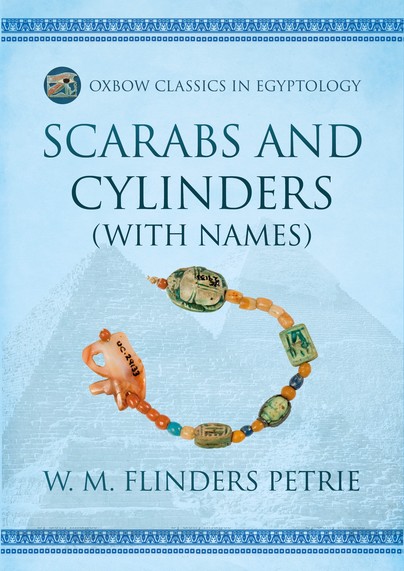
Format: Paperback
Pages: 130
ISBN: 9798888570029
Pub Date: 15 Feb 2023
Illustrations: Fully illustrated with photographs and line drawings
Description:
Facsimile edition of the 1974 reissue of Flinders Petrie’s 1917 pioneering typological catalogue of Egyptian name-scarabs and cylinders, one of a number of such catalogues to be reissued in this new series. The beetle form of amulets are common finds on Egyptian sites but examples with engraved names represent a small proportion of the total. Over 240 different royal persons are named among the various major museum collections.
Petrie here illustrates and discusses over 1,600 examples in his own collection together with a selection of inscribed steatite cylinders. He discusses the religious aspects of scarabs and their magical use, their varieties, materials and manufacture, and presents a chronological discussion with fully illustrated catalog of both line drawings and photographs. This volume is part of a new series comprising facsimile re-issues of typological catalogues produced between 1898 and 1937 by W. M. Flinders Petrie, based on his vast collection of Egyptian artefacts. Mostly excavated by Petrie during many seasons of campaign in the latter years of the 19th and early decades of the 20th century, these artefacts now reside in the Petrie Museum at University College, London. Long out of print, the catalogues were re-issued in facsimile by publishers Aris & Phillips in the 1970s alongside newly-commissioned titles, based on more recent examination of elements of the Petrie Collection by contemporary experts. The Oxbow Classics in Egyptology series makes a selection of these important resources available again in print for a new generation of students and scholars.
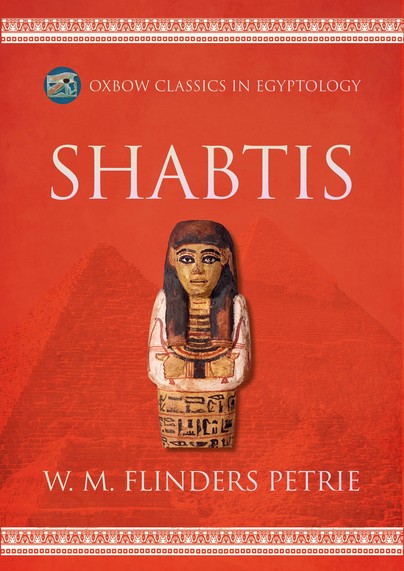
Format: Paperback
Pages: 68
ISBN: 9798888570067
Pub Date: 15 Feb 2023
Illustrations: Fully illustrated with photographs
Description:
This is a facsimile edition of the 1972 reissue of Flinders Petrie’s 1914 pioneering typological catalogue of Egyptian Shabtis, one of a number of such catalogues to be reissued in this new series. Shabtis, funeral statuettes made of stone or timber, were frequently encountered in early tomb and cemetery excavations. Petrie identified and describes a chronological sequence of development from simple statuettes emphasising the head, which appear to be substitutes for real heads that were often removed from the body, through to later detailed forms that he recognised as substitutes for the mummy.
He presents a discussion of the formula used in the inscriptions, their royal and sacred affinities, and identifies examples of additional texts. The examination of forms, formulaic inscriptions, materials and dating evidence is accompanied by transliteration of names, illustrated inscriptions, and over 650 photographed statuettes. This volume is part of a new series comprising facsimile re-issues of typological catalogues produced between 1898 and 1937 by W. M. Flinders Petrie, based on his vast collection of Egyptian artefacts. Mostly excavated by Petrie during many seasons of campaign in the latter years of the 19th and early decades of the 20th century, these artefacts now reside in the Petrie Museum at University College, London. Long out of print, the catalogues were re-issued in facsimile by publishers Aris & Phillips in the 1970s alongside newly-commissioned titles, based on more recent examination of elements of the Petrie Collection by contemporary experts. The Oxbow Classics in Egyptology series makes a selection of these important resources available again in print for a new generation of students and scholars.















